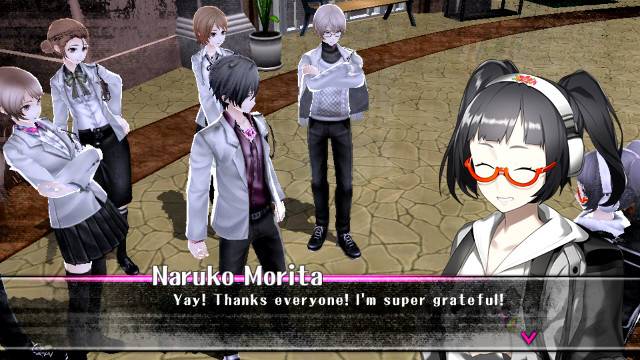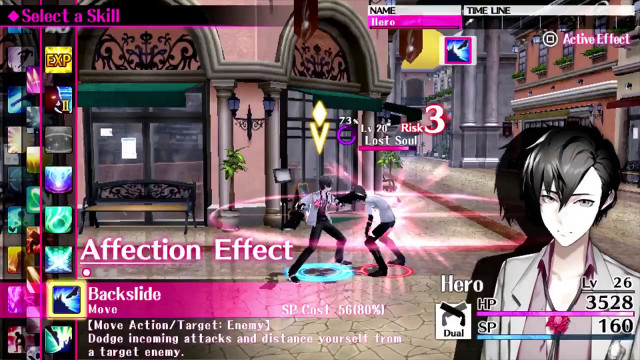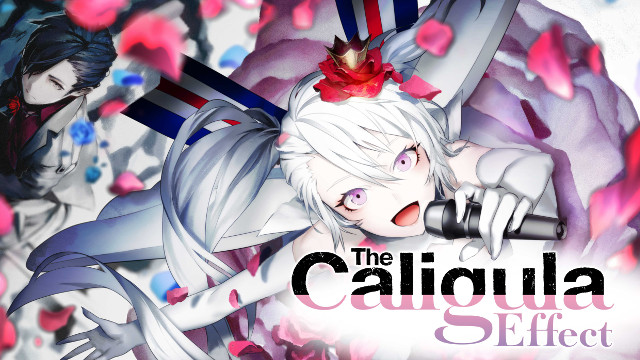A group of high school students are transferred to an alternate world where they must overcome their personal struggles to defeat monsters using special powers granted from said awakenings. Sound oddly familiar? That’s because The Caligula Effect is penned by Tadashi Satomi, famous for creating the story and characters of the first three Persona games. It is quite easy to draw comparisons between the two, both being published by Atlus, and just a month apart in release. However, there are major differences in quality and presentation between the two.
PS Vita fans may want to rejoice at an exclusive game that will fill the gaping hole left by the lack of Persona 5, but you’d be wrong to. A commonality you’ll see as this review goes on is that The Caligula Effect presents a JRPG-truck loaded with interesting ideas that are half-delivered at best, starting right from the opening moments.
A Deadly Effect
The Caligula Effect takes place in a Metaverse that you, the player, have been sucked into along with several members of your high school. The beginning of the game moves at a breakneck pace, moving from beat to beat before letting you loose to explore the dangerous digital world at your leisure. In doing so, the game misses out on introducing the characters you’ll be fighting alongside-and the combat itself in a meaningful way.
The game employs a combination of anime and in-game cutscenes to convey its psychologically-fueled story with mixed results. The 2D anime scenes suffer from bland art, devoid of much detail, while the game’s actual graphics are even worse. Jagged edges, recycled designs (both character and environment-wise), and static animations are just a few of the graphical issues. There is just something unnerving about a creepily smiling NPC that makes no effort to move their lips during a fully-voiced conversation.
The dark and mature story told over the course of the game is actually well-written and localized with great detail. Your goal is to leave this digital world through fighting its J-Pop idol overseer μ (pronounced “muu”) and her gang of Ostinato Musicians that try to stop you at all costs. Since music is a focal point of the story, it’s no surprise that the upbeat, catchy soundtrack composed by Tsukasa Mako is strongly implemented into the game. Instrumental versions of tracks will play as you wander around exploring, with the vocals bursting perfectly on cue when you transition to combat.
Linked Together

Throughout the game, you gather allies to join your “Go-Home Club”, raise their affinity for you, and complete Trauma Quests that unlock useful passive abilities for fighting. The Causality Link, or collection of all NPC students you can befriend, is similar to Confidants in Persona 5, except that there are over 500 total to unlock.
The Causality Link is an intricately designed web connecting every person in the game to each other. The depth here is profound and unique, with some people locked underneath layers of other friends you have to befriend before finally unlocking them. It is apparent that a lot of time was attributed to this feature, allowing you to even text back and forth simple messages to all the friends you have, with smaller features like bookmarking making it easier to find your favorite people.
This depth does have a negative effect on interactions with the NPC’s, causing a minimalist approach to conversations. Chatting with your 500 schoolmates is mostly short and uninteresting, and the game seems to understand that, letting you quickly skip through the text and rank up.
Excessive Combat

It’s unfortunate that the turn-based combat is so overburdened with mechanics and skills that it becomes a hassle to use. There are over 100 skills you can access across multiple tabs, ranging from actions like escaping, to attack skills to buffs to healing abilities and more. Even within just the attack skills, you have categories of counters, aerial attacks, and ground attacks to name a few. Each turn you get to pick several abilities at once to chain together for combos.
Before locking your choices in, the game gives you a preview of what will happen, including damage. This is a nice feature and a partial remedy for the easily forgettable skills. There are just so many that it’s hard to keep up with which is best to use after an aerial attack versus on the ground and so on. The difficulty is forgivable, so it is possible to just spam the basic attacks over and over majority of the time. Only in large groups or against the challenging bosses is there a need for any strategy.
However, those same battles have a different issue entirely as the frame rate can start to slow down the more there are enemies and animations onscreen. Battles and exploration take place seamlessly in the environment, so the camera can also be a significant problem, as you will fight and traverse through some narrow corridors where you’ll be looking at a wall instead of your party at times.
The game does reward your investment with a satisfying amount of content to enjoy, especially in the endgame. Your typical new game plus is available as well as a World Reward system. Finding hidden words unlock optional content that is much more challenging and range from level 40 all the way to 100. Beyond that, there are post-game dungeons to explore and replayable boss fights with enhanced difficulty.
Conclusion
The Caligula Effect is full of promising ideas that are bogged down by poor execution and lackluster presentation. The game tries too hard to do too many things all at once, resulting in obvious compromise.
There is a lot of content to experience, but it is all riddled with flaws, making it an unsuitable replacement for Vita fans disappointed in the lack of Persona 5.
-
A catchy soundtrack
-
Causality Link is unique and progressive
-
Lots to see and do after your adventure is complete
-
Unappealing graphics
-
Overwhelmingly complex
-
Boring combat
-
Technical shortcomings







